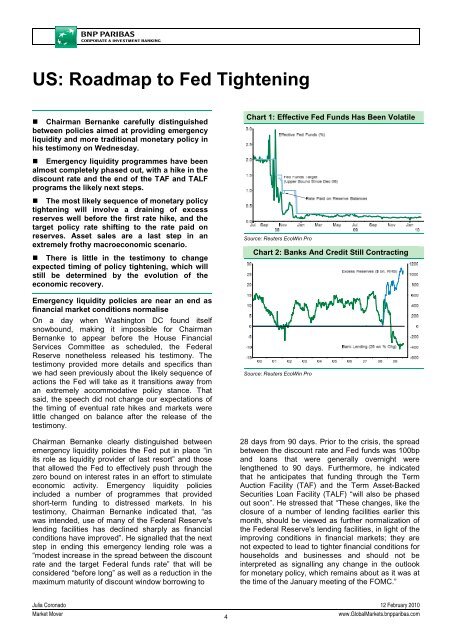Market Mover - BNP PARIBAS - Investment Services India
Market Mover - BNP PARIBAS - Investment Services India
Market Mover - BNP PARIBAS - Investment Services India
Create successful ePaper yourself
Turn your PDF publications into a flip-book with our unique Google optimized e-Paper software.
US: Roadmap to Fed Tightening<br />
• Chairman Bernanke carefully distinguished<br />
between policies aimed at providing emergency<br />
liquidity and more traditional monetary policy in<br />
his testimony on Wednesday.<br />
Chart 1: Effective Fed Funds Has Been Volatile<br />
• Emergency liquidity programmes have been<br />
almost completely phased out, with a hike in the<br />
discount rate and the end of the TAF and TALF<br />
programs the likely next steps.<br />
• The most likely sequence of monetary policy<br />
tightening will involve a draining of excess<br />
reserves well before the first rate hike, and the<br />
target policy rate shifting to the rate paid on<br />
reserves. Asset sales are a last step in an<br />
extremely frothy macroeconomic scenario.<br />
• There is little in the testimony to change<br />
expected timing of policy tightening, which will<br />
still be determined by the evolution of the<br />
economic recovery.<br />
Emergency liquidity policies are near an end as<br />
financial market conditions normalise<br />
On a day when Washington DC found itself<br />
snowbound, making it impossible for Chairman<br />
Bernanke to appear before the House Financial<br />
<strong>Services</strong> Committee as scheduled, the Federal<br />
Reserve nonetheless released his testimony. The<br />
testimony provided more details and specifics than<br />
we had seen previously about the likely sequence of<br />
actions the Fed will take as it transitions away from<br />
an extremely accommodative policy stance. That<br />
said, the speech did not change our expectations of<br />
the timing of eventual rate hikes and markets were<br />
little changed on balance after the release of the<br />
testimony.<br />
Chairman Bernanke clearly distinguished between<br />
emergency liquidity policies the Fed put in place “in<br />
its role as liquidity provider of last resort” and those<br />
that allowed the Fed to effectively push through the<br />
zero bound on interest rates in an effort to stimulate<br />
economic activity. Emergency liquidity policies<br />
included a number of programmes that provided<br />
short-term funding to distressed markets. In his<br />
testimony, Chairman Bernanke indicated that, “as<br />
was intended, use of many of the Federal Reserve's<br />
lending facilities has declined sharply as financial<br />
conditions have improved”. He signalled that the next<br />
step in ending this emergency lending role was a<br />
“modest increase in the spread between the discount<br />
rate and the target Federal funds rate” that will be<br />
considered “before long” as well as a reduction in the<br />
maximum maturity of discount window borrowing to<br />
Source: Reuters EcoWin Pro<br />
Chart 2: Banks And Credit Still Contracting<br />
Source: Reuters EcoWin Pro<br />
28 days from 90 days. Prior to the crisis, the spread<br />
between the discount rate and Fed funds was 100bp<br />
and loans that were generally overnight were<br />
lengthened to 90 days. Furthermore, he indicated<br />
that he anticipates that funding through the Term<br />
Auction Facility (TAF) and the Term Asset-Backed<br />
Securities Loan Facility (TALF) “will also be phased<br />
out soon”. He stressed that “These changes, like the<br />
closure of a number of lending facilities earlier this<br />
month, should be viewed as further normalization of<br />
the Federal Reserve's lending facilities, in light of the<br />
improving conditions in financial markets; they are<br />
not expected to lead to tighter financial conditions for<br />
households and businesses and should not be<br />
interpreted as signalling any change in the outlook<br />
for monetary policy, which remains about as it was at<br />
the time of the January meeting of the FOMC.”<br />
Julia Coronado 12 February 2010<br />
<strong>Market</strong> <strong>Mover</strong><br />
4<br />
www.Global<strong>Market</strong>s.bnpparibas.com
















